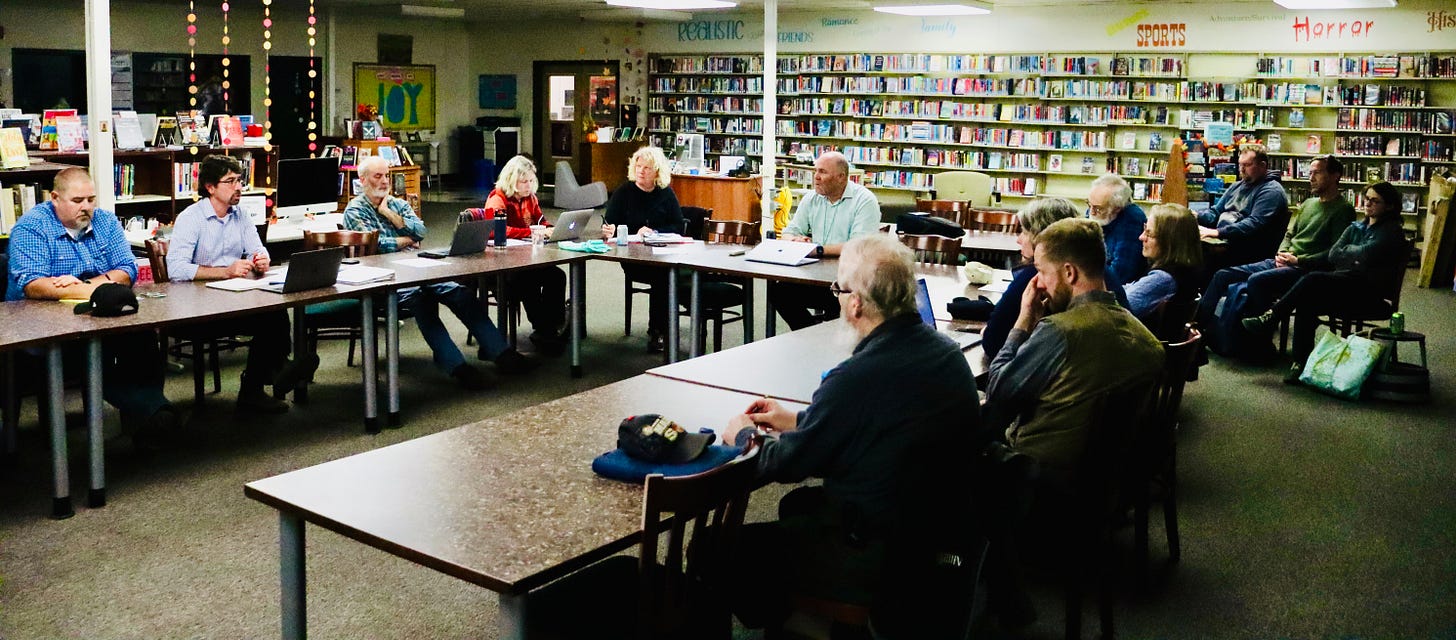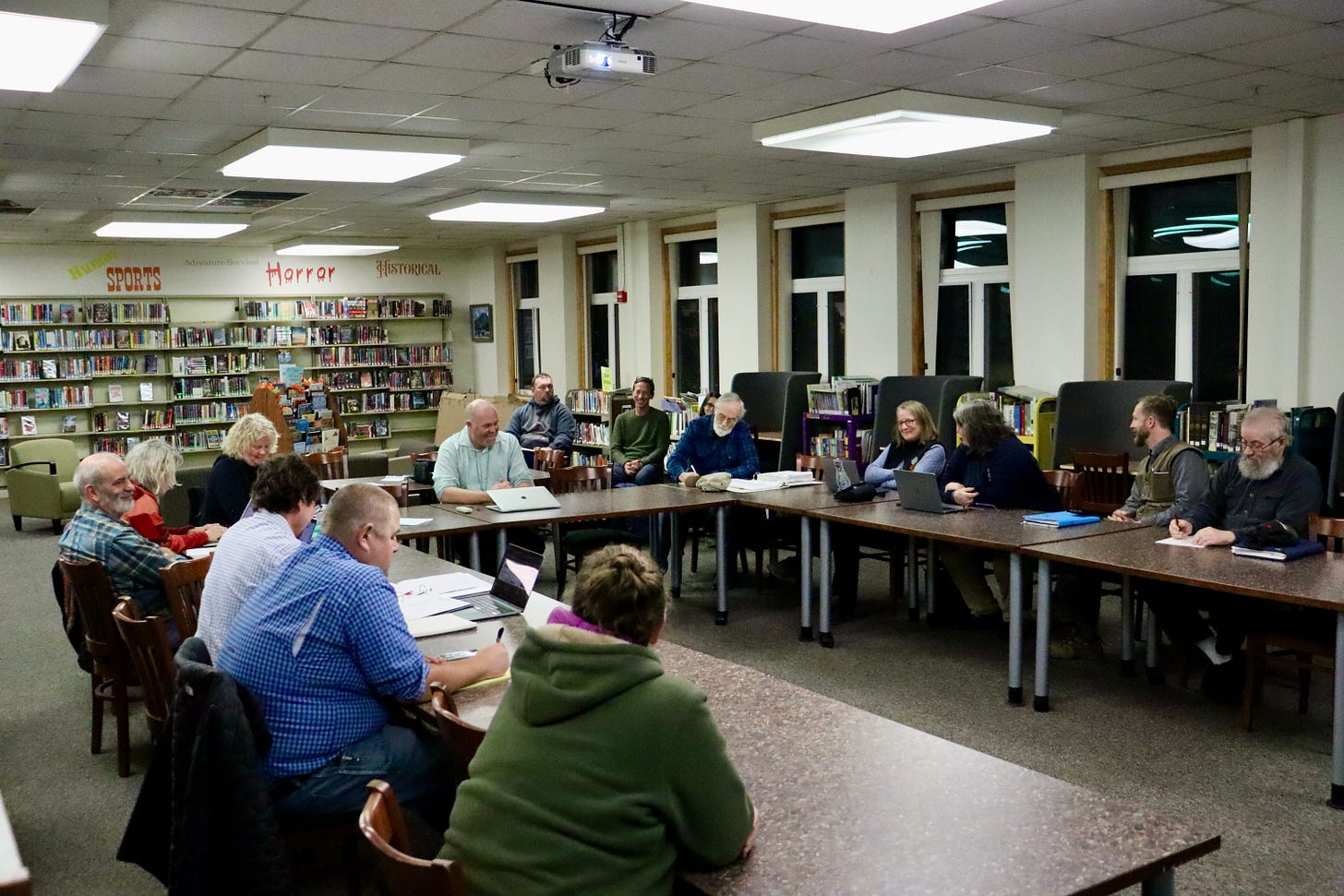Debts and Buildings:
Who will pay (and who will own) if school consolidation and reorganization occurs?
BAR HARBOR––It’s currently uncertain what will happen to each town’s debt for school projects if the school system reorganizes and who will own each school property.
That became clear at Monday night’s MDI High School Board of Trustees meeting, which centered mostly around planning for future projects. During a discussion regarding strategic planning of how to present the proposed $16 million science wing reconstruction to town governments and residents, member Carole Plenty asked how the reorganization of the school system would play into building projects.
MDI High School Principal Matt Haney said, “From my perspective as a high school principal, I think if we wait until that question is completely settled, we will have to start all over again. I think that depending upon how that reorganization plays out, there are ramifications for who owns the building, who owns the debt, if it (the AOS 91 school system) is consolidated.”
The system is currently in the process of looking at consolidation and reorganizing. Multiple options for that consolidation have been laid out and a committee has been formed to look at that potential. It would have to be approved by town voters.
“I think those are the pieces that the reorganization committee will be looking at and what the law may say about ownership of buildings and about debts and how that may be acquired by the district and what process that looks like. That is something that that team will decide how you do that in reorganization,” Superintendent Mike Zboray said.
Zboray also said that is part of the process, the drawing out what your plan is, and there are a lot of unknowns. The goal, he said, is to have a single system that is equitable for students, teachers, and municipalities. They wouldn’t necessarily drop the changes on the communities and it is a process that can be phased in, he said.
Haney said that a positive is that the high school is already consolidated and would likely only be tweaked a bit. The bigger question is what happens to the school debts in the other individual towns, Haney said. Those conversations are outside of the purview of the High School Board of Trustees.
A bond for $58,538,288 was approved by Bar Harbor voters on June 13 for the construction of a new school building to replace the aged and ailing Connors Emerson school buildings. This debt currently rests squarely on the shoulders of Bar Harbor taxpayers.
The $16 million debt for the proposed high school construction project would be split amongst all four towns on the island at the percentages they will be paying when the bond is approved and taken out. The current percentage rates for each town are below.
· Bar Harbor – 37.79%
· Mount Desert – 35.6%
· Southwest Harbor – 14.29%
· Tremont – 12.32%
What would happen to school-related debt and property ownership for each of the four towns are the bigger questions that need to be figured out by the Reorganization Planning Committee with the assistance of experts in how it has been done in other places, according to Zboray.
COMMUNITY OUTREACH STRATEGY FOR HIGH SCHOOL BUILDING PROJECT
Haney said that Oak Point Associates (the engineers/architects for the building project) is building a construction-project-based website and will also be producing flyers for the purpose of educating the public regarding the high school’s building project. Oak Point will also accompany and support the Board of Trustees when they are doing community forums and presentations to councils and select boards.
The building project is a reconfiguration and modernization of the school’s science wing and library.
An Oak Point representative suggested doing a couple of late winter or very early spring forums on the MDI High School campus prior to beginning presentations to the different town governments.
At a September 25 meeting of the Board of Trustees, William Stockmeyer of the Portland law firm, Drummond and Woodsum, said that technically, if the bond vote passes in each town, each particular town is liable for the entire bond amount of roughly $16 million in the highly unlikely event of a loan default.
At Monday’s meeting, Haney said that in the extremely low chance of default, towns would owe their share of the cost but every town would take on the responsibility for the total debt. The current percentage-based share by town is listed above.
Haney said that after the forums and presentations, a public hearing would then be required within four weeks of the referendum date and that event would take place at the high school.
Member Lawson Wulsin asked if the website or other informational material will have answers to people’s possible questions.
Haney said that Oak Point is planning on making both the website and the flyers very informative and they will also have a frequently asked questions type section.
Vice Chair Ann Ratcliff said the trustees need to understand the project well and be able to answer any questions that community members may have.
It is very important to make sure that everyone is well informed and that when you leave (after holding a forum in a particular town) that you are pretty confident that the town is in favor of the project, said member Robert Webber.
“Now we have so many problems in Bar Harbor, the project that they are building, the fact that we have so many properties that are not taxable, I think that if we are not ready for Bar Harbor and we can’t get Bar Harbor on board, then I don’t think we have a chance,” Webber said. “If we can go in there and answer all of the questions, we can do it, but it will be a tough job.”
Member Kerri Hayes said that she think it would be important to we invite people to come to the high school and be able to have a chance to see the science labs so they can see how out of date they are.
“It’s like walking back into the sixties,” said Hayes.
WASTEWATER DISPOSAL UPDATE
Zboray said that he met with Mount Desert’s Wastewater Superintendent and the town’s engineers on November 13 to see if the anticipated $5 million project to pump wastewater from the high school to the Somesville wastewater treatment plant is feasible. The outcome of that meeting was that based on projected flow rates from the high school and the capacity of the plant the answer is yes.
They are still figuring out funding questions and options Zboray said. Because the school is located in Bar Harbor but will be pumping to Mount Desert, he wondered if there are potential avenues of funding for both towns. He said they are investigating if there are more funding options from either or both towns as opposed to just the school trying to get alternative funding?
Zboray said that since they have learned that it is preferable to put infrastructure like that down the middle of the roadway rather than along the side of the road, they are trying to forecast if Maine Department of Transportation has any road projects in the next couple of years that would coincide with the wastewater project.
One Board of Trustees member asked if a grant or funding had to come from a municipality that has land involved in the project or if it could come from any member supporting the high school.
Zboray said that is the question that he needs to ask. He doesn’t know if it is just restricted to Bar Harbor or Mount Desert or if all the towns can play a role because the high school is consolidated.
According to Mount Desert Public Works Director Brian Henkel, the project is feasible based upon anticipated flow rates from the high school. One issue might be that there are three pump stations between the school and the treatment plant that all have to handle the flow. So, the way to do it is to pump it at specific rates that don’t overwhelm what the system is already pumping rather than trying to upgrade all of the existing system.
Because of the capacity of the existing holding tank, that can probably happen, Henkel said. If the school is just sending liquids, it is much easier to accomplish but if the school sends solids as well, it requires a higher flow rate, which would make it harder. They are still working on where the ownership lies and who will own the system. Because there would be pump stations in different towns, who maintains them is still a question to be answered.
Henkel also said that PFAS levels coming out of the high school currently are much higher than what they currently have as a baseline for PFAS levels received at the Somesville plant, so continuing to try and drop those outgoing PFAS levels from the high school to a level closer to what the pump station currently handles is important.
Zboray said that the wastewater consultants, Haley Ward, are planning on measuring the depth of the sludge in the wastewater containment ponds during the week of December 8. Sludge is very expensive to dispose of and knowing the depth of the sludge will help them estimate the costs of decommissioning the ponds which would have to happen after the system to Somesville is complete and functioning.
As far as the Notice of Violation from the Department of Environmental Protection, Zboray said that the DEP wants the school to install a monitoring system to monitor the ponds for leakage. Other than that, the school is still in compliance and can continue to use the system at least until their current licenses expire.
BOARD OF TRUSTEES BUDGET
Haney said that the current trustees budget, including debt service and capital improvement is $776,496. Any money not spent from this year’s budget will go toward the minor capital reserve. If they maintain their stated 3% yearly increase, the budget will increase to $799,791 for next year. From this year’s budget, $108,000 has been earmarked for a payment toward the walls and windows project which only has a total of three payments remaining before that debt is fulfilled.
Other upcoming large expenditure projects are the wastewater project, the building project, the running track, the purchasing of the solar panels, and the school roofs, Haney said.
Concerning the roofs, Haney said, the science wing roof would be replaced as part of the building project. The gym roof, which needs replacement, cannot be done until the school owns the solar panels that sit atop it because if they disconnect them to redo the roof, the company that currently owns them would charge the school a million-dollar surcharge.
Once the solar panels are paid for, the majority of the school’s almost $100,000 a year electricity payment will be eliminated.
The next meeting of the Board of Trustees will be December 18, at 5:30 p.m., in the high school library.








LMBs - High School Principal Matt Haney said, "The anticipated lifespan of our solar array is 25 years. They were installed in the fall of 2019 so they should be fully functional through 2044. It's likely that they will continue to produce power beyond the 25 years, but that's the lifespan that the installation company states as an official lifespan."
What is the lifespan of the solar panels on the high school?